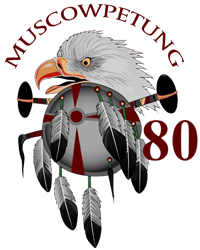Muscowpetung Saulteaux Nation
The Muscowpetung Saulteaux Nation is a Saulteaux band government in southern Saskatchewan, Canada.[5] Their reserves include:
- Last Mountain Lake 80A, shared with 6 other bands
- Muscowpetung 80
- Treaty Four Reserve Grounds 77, shared with 32 other bands.
 | |
| People | Saulteaux |
|---|---|
| Treaty | Treaty 4 |
| Headquarters | Fort Qu'Appelle |
| Province | Saskatchewan |
| Land[1] | |
| Reserve(s) | |
| Land area | 88.49 km2 |
| Population (2019)[2] | |
| On reserve | 330 |
| Off reserve | 1145 |
| Total population | 1475 |
| Government[3] | |
| Chief | Anthony Cappo |
| Tribal Council[4] | |
| File Hills Qu'Appelle Tribal Council | |
| Website | |
| muscowpetung.com | |
History
1874 - 1909: The Queen's representatives set apart reserve land and entered into Treaty 4, also known as the Qu'Appelle Treaty on September 15, 1874 at Fort Qu'Appelle, Saskatchewan with the Muscowpetung Saulteaux band. In exchange for payments, provisions and rights to reserve lands, Treaty 4 ceded Indigenous territory to the federal government.[6]
1909: On January 4, 1909 band members and elders were summoned at noon by an Indian Agent who claimed he was representing the Crown. At 11:00 pm those in attendance gave into pressure and accepted cash payments offered by the agent in exchange for 17,600 acres of prime agricultural land amounting to almost 47% of the original reserve area. There were several documented cases of Indian Agents purchasing surrendered land despite the Indian Act prohibiting such purchases.
| The power of Indian Agents and other Department officials over life on reserves was impressive, and was an important influencing factor in the context of surrenders. Under the pass system that was employed after 1885, band members were required to obtain passes from the Agents in order to leave their reserves. This system served to restrict movement between reserves and to prevent political and religious gatherings. Agents also supervised spending and distributed housing, clothing, and rations. In all these matters, Agents were given a good deal of discretion, loosely supervised by regional Inspectors.[7] |
|---|
References
- "First Nation Detail". Indigenous and Northern Affairs Canada. Government of Canada. Retrieved September 10, 2019.
- "First Nation Detail". Indigenous and Northern Affairs Canada. Government of Canada. Retrieved September 10, 2019.
- "First Nation Detail". Indigenous and Northern Affairs Canada. Government of Canada. Retrieved September 10, 2019.
- "First Nation Detail". Indigenous and Northern Affairs Canada. Government of Canada. Retrieved September 10, 2019.
- "First Nation Detail - Muscowpetung". Indigenous and Northern Affairs Canada. Retrieved 22 December 2017.
- "Treaty 4 | The Canadian Encyclopedia". www.thecanadianencyclopedia.ca. Retrieved 2019-01-18.
- Martin-McGuire, Peggy (1998-09-01). "FIRST NATION LAND SURRENDERS ON THE PRAIRIES 1896 - 1911" (PDF). publications.gc.ca. Retrieved 2019-01-18.